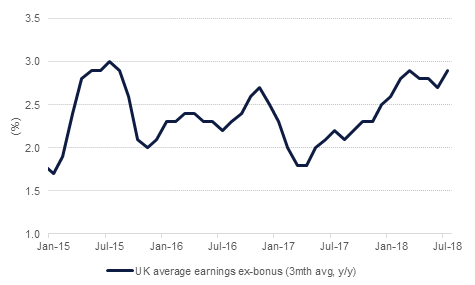
UK employment data came in better than expected for the three months up to July. Wage growth hit a three month high of 2.9% y/y (when excluding bonuses) while the overall unemployment rate held at its multi-decades low of 4%. Only 3k new jobs were added over the period, below market expectations. The levelling off of employment growth may give the BoE pause as it considers the trajectory for the UK economy ahead of Brexit coming into effect early next year. The BoE’s governor, Mark Carney, will stay on for an extended term into 2020 in order to help manage the UK move away from the EU.
Germany’s ZEW index came in better than anticipated for the September print. The economic sentiment component moved up to -10.6 from -13.7 in August while the current conditions estimate was 72, only slightly softer than the previous month.
US job openings hit a record level of 6.9m in July, complimenting a strong non-farm payrolls reported at the end of last week. The Labor Department’s JOLTS report showed that the number of workers voluntarily quitting their jobs in the prospect of getting something better also moved higher to 2.4%. The demand for labour will help to keep a fire under wages which already showed signs of solid gains last month, rising by 2.9% y/y.
PIF, Saudi Arabia’s sovereign wealth fund, has reportedly agreed a USD 11bn with a consortium of banks. Following the postponement of the IPO of Saudi Aramco PIF has been needing to raise funds to help meet Saudi Arabia’s diversification plans and to invest in assets both domestically and internationally. The loan was reportedly prices at LIBOR +75bps.
 Source: EIKON, Emirates NBD Research
Source: EIKON, Emirates NBD Research
Treasuries closed lower following a slight improvement in risk appetite. Yields on the 2y UST, 5y UST and 10y UST closed at 2.74% (+3 bps), 2.86% (+4 bps) and 2.97% (+4 bps).
Regional bonds continued to drift lower. The YTW on the Bloomberg Barclays GCC Credit and High Yield index rising +1 bp to 4.49% and credit spreads tightening 2 bps to 167 bps.
According to Reuters, Saudi Arabia may announce a USD sukuk issuance in the near term.
Despite constructive UK employment data, chief EU Brexit negotiation Michel Barnier stating that a deal is “do-able” within the next eight weeks and Bank of England Governor Carney extending his term to 2020, GBPUSD declined yesterday retreating below the 50-day moving average breached on Monday, with a daily close below this key level. As we go to print, GBPUSD is trading at 1.3011 with resistance expected at 1.3085, the cross’s five-week high and initial support expected at 1.2960.
Over the remainder of the week, markets will turn their focus towards the Bank of England which will meet on Thursday to discuss monetary policy. While no changes are expected, investors will be curious to analyse the communication of Governor Mark Carney who last stated that the risk of Britain leaving the common market with no deal in March in 2019 was “uncomfortably high”. Following the increase in optimism that a deal can be reached, investors will be keen to see whether Carney’s opinion has changed since then.
Developed market equities closed higher following a lull on the trade front and rebound in tech shares. The S&P 500 index added +0.4% while the Euro Stoxx 600 index closed flat.
Regional equity markets closed mixed with the Qatar Exchange adding +0.4% and the DFM index losing -0.6%. Real estate stocks remained under pressure with Emaar Properties losing -1.0%.
Oil prices gained more than 2% in both Brent and WTI thanks growing anxiety over a shortfall expected from Iran and a decline in inventories reported by the private sector. The API reported a drop of 8.6m bbl last week in crude stocks while the impact of Hurricane Florence threatening the US east coast mean fuel shortages are developing.
The EIA revised lower its forecast for oil supply growth from the US in 2019. The government forecasting agency now expect oil supply from the US to expand by 840k b/d, down from over 1m b/d that it had forecast previously. For 2018, the EIA expects growth at 1.3m b/d. The spread between WTI and Brent has widened considerably again in recent weeks, hitting as much as USD 10/b while the prices for producers in the main production centres of Texas are facing even bigger discounts for their crude as they struggle with access to pipelines. These infrastructure constraints are evidently behind the lower forecast for oil supply in 2019.
Click here to Download Full article